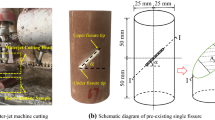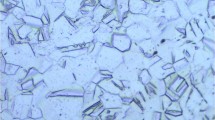Abstract
To investigate the effect of acid corrosion on the mechanical properties of the Diorite specimens, obtained from Qian Chang Copper mine in China, the specimens were first saturated in neutral water and acid solutions with pH values of 3 and 5 for 49 days. Then, electronic scanning tests, uniaxial compression tests and triaxial compression tests on the saturated and dry specimens were sequentially performed. The results show that the acid corrosion, causing micro damages on the specimens, decreased the unixial compression strength, the triaxial compression strength, the cohesion and the internal friction angle. In addition, the decrease degree was negatively to the pH value. Third, the acid corrosion promoted the ductility of the specimens.











Similar content being viewed by others
References
Atkinson BK, Meredith PG (1981) Stress corrosion cracking of quartz: a note on the influence of chemical environment. Tectonophysics 77(1–2):T1–T11
Brzesowsky RH, Hangx SJT, BrantutN SpiersCJ (2014) Compaction creep of sands due to time-dependent grain failure: effects of chemical environment, applied stress, and grain size. J Geophys Res Solid Earth 119(10):7521–7541
Cai YY, Yu J, Fu GF, Li H (2016) Experimental investigation on the relevance of mechanical properties and porosity of sandstone after hydrochemical erosion. J Mat Sci 13(11):2053–2068
Chen GL, Zhou RD (1991) Experimental study on macroscopic mechanical effect of water on deformation and failure of forced rock. Chinese J Geophys 34(3):335–342
Chen SL, Feng XT, Zhou H (2003) Experimental study on triaxial compression mechanical effect of sandstone under chemical corrosion. J Northeast Univ 24(3):292–295
Corkum AG, Martin CD (2007) The mechanical behaviour of weak mudstone (Opalinus Clay) at low stresses. Int J Rock Mech Min Sci 44(2):196–209
Dunning J, Douglas B, McdonaldS Miller (1994) The role of the chemical environment in frictional deformation: stress corrosion cracking and comminution. Pure appl Geophys 143(1–3):151–178
Felice SL, Montanari D, Battaglia S (2014) Fracture permeability and water–rock interaction in a shallow volcanic groundwater reservoir and the concern of its interaction with the deep geothermal reservoir of Mt. Amiata, Italy. J Volcanol Geoth Res 284:95–105
Feng XT, Ding W (2007) Experimental study of limestone micro-fracturing under a coupled stress, fluid flow and changing chemical environment. Int J Rock Mech Min Sci 44(3):437–448
Feng XT, Ding W, Zhang D (2009) Multi-crack interaction in limestone subject to stress and flow of chemical solutions. Int J Rock Mech Min Sci 46(1):159–171
Feucht LJ, Logan JM (1990) Effects of chemically active solutions on shearing behavior of a sandstone. Tectonophysics 175(1):159–176
Gawin D, Pesavento F, Schrefler BA (2003) Modelling of hygro-thermal behaviour of concrete at high temperature with thermo-chemical and mechanical material degradation. Comput Methods Appl Mech Eng 192(13):1731–1771
Hawkins AB, Mcconnell BJ (1992) Sensitivity of sandstone strength and deformability to changes in moisture content. Q J Eng GeolHydrogeol 25(2):115–130
Heggheim T, Madland MV, Risnes R, Austad T (2005) A chemical induced enhanced weakening of chalk by seawater. J Petrol Sci Eng 46(3):171–184
Hutchinson AJ, Johnson JB, Thompson GE, Wood GC, Sage PW, Cooke MJ (1993) Stone degradation due to wet deposition of pollutants. Corros Sci 34(11):1881–1898
Karfakis MG, Akram M (1993) Effects of chemical solutions on rock fracturing. Int J Rock Mech Min Sci Geomech Abstr 30(7):1253–1259
Kawakata H, Cho A, Yanagidani T, Shimada M (1997) The observations of faulting in westerly granite under triaxial compression by X-ray CT scan. Int J Rock Mech Min Sci 34(3–4):151.e1–151.e12
Li HZ, He MC (1995) Study on mechanical and chemical properties of expansive soft rock. Coal 6:9–12
Li N, Zhu YM, Su B, Gunter S (2003) A chemical damage model of sandstone in acid solution. Int J Rock Mech Min Sci 40(2):243–249
Nguyen VH, Nedjar B, Torrenti JM (2007) Chemo-mechanical coupling behaviour of leached concrete: part II: modelling. Nucl Eng Des 237(20–21):2090–2097
Pietruszczak S, Lydzba D, Shao JF (2006) Modelling of deformation response and chemo-mechanical coupling in chalk. Int J Numer Anal Meth Geomech 30(10):997–1018
Rebinder PA, Shreiner LA, Zhigach KF (1948) Hardness reducers in drilling: a physico-chemical method of facilitating the mechanical destruction of rocks during drilling. Council for Scientific and Industrial Research, Melbourne
TaronJ Elsworth D, MinKB (2009) Numerical simulation of thermal-hydrologic-mechanical-chemical processes in deformable, fractured porous media. Int J Rock Mech Min Sci 46(5):842–854
Wang W, Li XH, Zhu Z, Shi C, Xu WY (2017) Experimental study of mechanical characteristics of sandy slate under chemical corrosion. Rock Soil Mech. https://doi.org/10.16285/j.rsm.2017.09.012
Xie SY, Shao JF, Burlion N (2008) Experimental study of mechanical behaviour of cement paste under compressive stress and chemical degradation. Cem Concr Res 38(12):1416–1423
Yang X (2010) Experimental study on the influence of water and chemical solution on the mechanical properties of rock. Dissertation, Hubei University of Technology (in Chinese)
Zhu YM (2001) Experimental study on strength and deformation properties of sandstone in acidic environment. Dissertation, Xi’an University of Technology (in Chinese)
Funding
Funding was provided by National Natural Science Foundation of China (Grant No. 51774132).
Author information
Authors and Affiliations
Corresponding author
Additional information
Publisher's Note
Springer Nature remains neutral with regard to jurisdictional claims in published maps and institutional affiliations.
Rights and permissions
About this article
Cite this article
Xie, S., Wan, W. Mechanical Damage to the Diorite Caused by Acid Corrosion. Geotech Geol Eng 38, 3087–3094 (2020). https://doi.org/10.1007/s10706-020-01209-5
Received:
Accepted:
Published:
Issue Date:
DOI: https://doi.org/10.1007/s10706-020-01209-5




